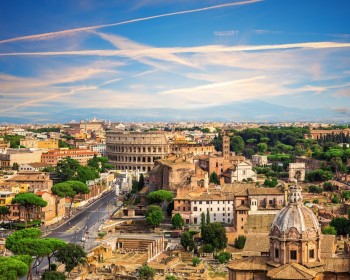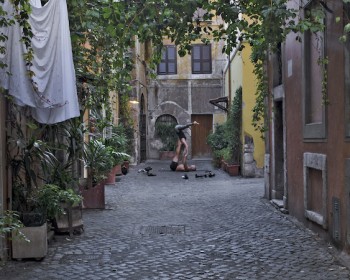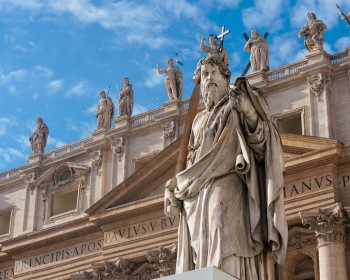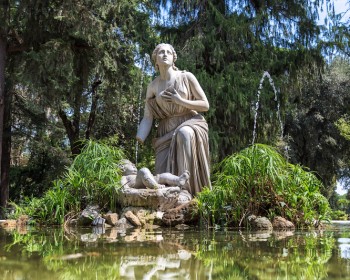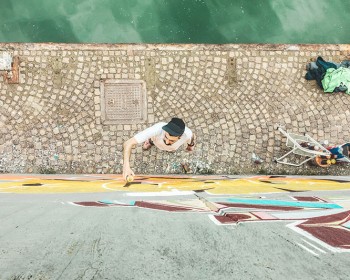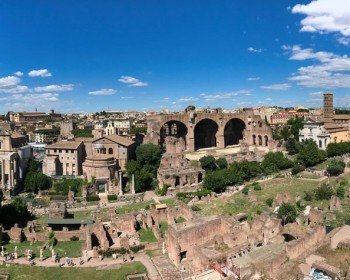Have you ever gone up the Spanish Steps? I know it seems like a stairway to heaven for the innumerable steps, I mean nobody can understand you better than a lazy person like me! But if it is not the first time you are in Rome, or if you have already visited the must-sees of the city, or well if you just want to see something different and kept secret, I would totally advice you to visit the "Palazzo Zuccari" hidden from visitors in a famous place like Trinità dei Monti square.
Spanish steps of course don't bring you to heaven like the famous stairway that "she's buying" in Led Zeppelin song but on the top of the stairs you will have absolutely a breathtaking view of all the city. So even if a little bit tiring - when I got there I was out of breath - it is worthy of it!
After you have gone upstairs, exactly on your right you will find "Palazzo Zuccari", an XVI century building located at the crossroads of via Gregoriana and via Sistina. These two streets are historically important because the former was constructed during the Jubilee in 1575 by Pope Gregorio XIII so that link Trinità dei Monti was linked to the underlying city and for this reason it took the place of a stairway built by the architect Fontana to simplify the access to the Pincian Hill as well. The latter, on the other hand, was used to connect St. Mary Major Church to Trinità dei Monti and its name derives from the Pope Sisto V who created it working together with the aforesaid architect Fontana.
Federico Zuccari, the italian artist
Federico Zuccari, from whose family name the building takes its appellative, was an Italian artist who painted the frescoes of the cupola of Saint Mary of the Flower realized by Brunelleschi in Florence. Zuccari decided to build a sumptuous home to show the greatness he reached, the importance and the eccentricity of the artist even in the exterior of his house planning a more impressive project than the one he had already developed in Florence.
In 1590 he bought an enviable plot of land, right near Trinità dei Monti's Church and started to build one of the most important examples of artist's house in Italy. Going ahead with works he had to change his projects because it turned out they were leaving him destitute. Before he died he had decided to leave its house to the Academy of Saint Luca, and after lots of transfers of properties Palazzo Zuccari was rented to Maria Casimira, the Queen of Poland who expanded it and had a portico built by Filippo Juvarra, an Italian architect who used to work at the service of the Savoia family in Turin. Furthermore, she put the Poland coat of arms on the façade overlooking Trinità dei Monti square.
Do you love Art? Join our Borghese Gallery Private Group Tour!
The artists who lived in Zuccari Palace
After Zuccari died many artists stayed at "Palazzo", among them Johann Joachim Winckelmann and Jacques-Louis David who painted "the Oath of the Horatii" right there in 1785; at the end it was sold to Enrichetta Hertz and since the early 1900's the Palazzo Zuccari hosted "Biblioteca Hertziana" specialized in Italian History of Arts. Enrichetta expanded the complex to include another building in a former garden which was soon filled with a vast collection of books and paintings. When she died she donated the painting collection to the Italian state, and the book collection to the German one which still takes care of the library. The Biblioteca Hertziana is not just one of the most beautiful libraries in Rome, it is one of the first places dedicated to the humanities as well. It houses a photo library too and it is one of the most renown research centers for the Italian art history in the world.
Palazzo Zuccari was chosen by Gabriele D'Annunzio - an Italian writer, poet, journalist, playwright and soldier during World War I - as the house of Andrea Sperelli, the main character of his book "Il Piacere" ("the Pleasure"). At one point of the book Andrea Sperelli himself says that "Palazzo Zuccari contains, like a vase an essence, the whole absolute lovability of Rome". Arts and life here try to coincide leaving people speechless like the big mask located at the entrance and welcoming visitors.
The Monsters House
Speaking of it, from an architectural point of view the peculiarity of the building is exactly the shape of the cornices of the external windows that have the aspect of big monstrous open mouths. The cornice of the door has the same shape too as if this big mouth is swallowing people entering the threshold; a nose takes the place of the capstone and eyes with eyebrows replace the tympanum, everything is inspired to the Garden of Bomarzio and to the Mannerist architecture in general. For these characteristics Palazzo Zuccari is also known as "the Monsters House".
The aim of the artist was to stun and frighten visitors who hesitate at first sight and once inside would appreciate the contrast between the initial feeling and the magic of the garden. If you are wondering how it is possible that this famous building or library is hidden from the people even if it is located in a famous square at the bottom of an even more famous stairway, I can just tell you are right.
But so it is, I have been living here in Rome for five years and if I would not have read about it coincidentally I would have never got to know it. It seems people are so used to see the beauty around them walking through Rome highlights, that gems like this remain concealed or, even worst, taken for granted.
So here I am, to share with you what I think fascinating, interesting and to show you one by one the different aspects of this magnificent city!



